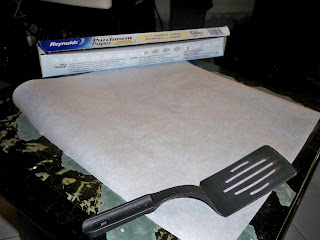Cream
one stick of butter with one heaping cup of sugar. My advice: if you
are buying french butter, don't try to soften it too long. It melts
quickly! Use a fork! If you can find sugar that's less grainy, your
cookies will be better.
Mix with a fork until sugar and butter are well blended, then add one well beaten egg and mix again... Add one tablespoon or cream or milk.
Add flour slowly. Two cups total. Mix until all the excess flour is blended. (You may need to rest your hand. I don't know if an electric mixer would work as well as good old-fashioned mixing by hand.)
You
will probably need to use fork to get the dough out of the bottom of
the bowl. Make a ball. Divide the ball into two equal bowls. (One is
too large to roll out).
Now, rolling out cookie dough turned out to be very good practice at rolling out pie crusts
First, sprinkle a clean surface with flour. Don't bother trying to spread it around with your hands yet. If the surface is dry, you will just make the flour uneven. Sprinkle one ball of dough with flour and set it down on the middle of the floured surface. Begin to roll it out. Roll it counterclockwise, like so: roll over the ball once, turn your pin at a 45 degree angle, roll again, repeat. Continue until the dough is halfway (or a little less) rolled out. Now, for the secret to not having your dough stick to the table:
Pick up the rolled dough, then sprinkle more flour onto the void. Turn the dough over before you place it back on the table. Now, all the flour from the bottom is on top! Just use your hand to brush the flour around on the dough. Keep rolling in the same counter-clockwise manner.
When the dough begins to look slightly see-through, it's time to use your cookie cutter. The original recipe says to roll the dough to 1/8th of an inch thick, and I might over do it. These cookies are really great when they are crispy little crackers. Ira's favorites are the ones that are almost burned.
You'll still need to be careful when you are transferring the cookies to the cookie sheet. My secret to keeping the dough from sticking isn't a cure-all. I usually remove the scraps first and make a ball with them before I tackle the delicate job of cookie transferring.
The great thing about being done with the first roll-out is that the table is now moist from the dough and it is easier to flour evenly. You can brush the excess flour back over the table with your hand and add more if you need to.
For sugar cookies, I've found that buttering the cookie sheet is a waste of an expensive product, makes the cookies look fried, and adds extra (unwanted) calories. A baking mat is definitely an investment that will pay off!
Bake the cookies at 475 for 5 minutes. You'll have to watch them closely! My oven doesn't get that hot, so I had to bake mine at 320ish for 10-15 minutes (which might work better for people who can't hover over their stove for so long).
Thanks to my mother in law, I actually happened to have a roll of parchment paper on hand. Since platters are in short supply for me, I just use parchment paper to cool my cookies. Who needs a cooling rack? (...which, by the way, I never used or understood the point of...though I suppose there is one...)
I have discovered that the best way to clean the dough off of your table or counter (now, PLEASE don't do this to your expensive dining room table, as it might scratch it) is to use the cookie cutter to scrap all the dough and flour into the trash can.



























No comments:
Post a Comment